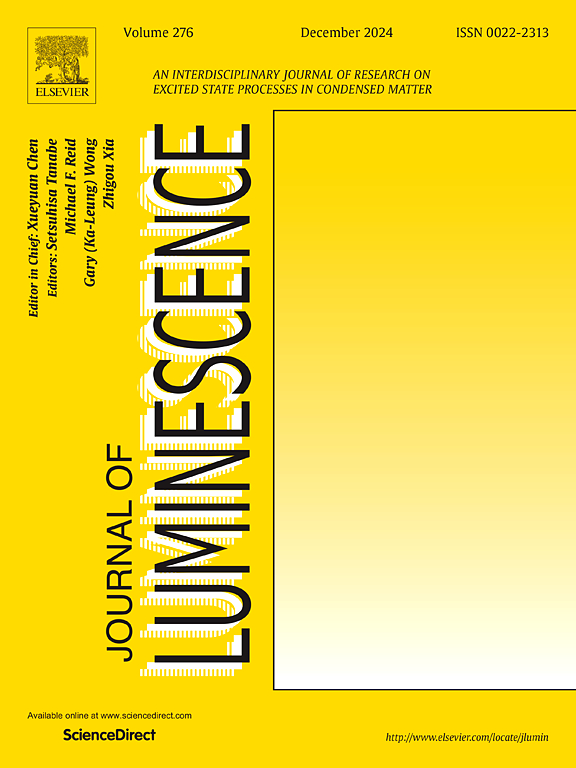Selective and sensitive sensing of Hg2+ and furazolidone antibiotic using flexible anthracene based sensor
IF 3.3
3区 物理与天体物理
Q2 OPTICS
引用次数: 0
Abstract
A new fluorescent anthracene based probe, 9,10-bis((pyridine-2-ylthio)methyl)anthracene (ANSN) with 2-mercaptopyridine as receptor at 9 and 10 positions has been synthesized. ANSN selectively and sensitively detects the presence of toxic Hg2+ ion and furazolidone (FZD) antibiotic in water via turn off mechanism with detection limits of 0.80 μM and 0.12 μM, respectively. The sensor was characterised by 1H NMR, 13C NMR and single crystal X-ray diffraction techniques. The ANSN crystallizes in monoclinic crystal system with C2/c space group and the pyridine-2-ylthio group adopts the anti-conformation with reference to the plane of anthracene unit. The removal of Hg2+ is very important as it is one of the toxic heavy metal presents on the earth that occurs in three forms-elemental, organic and inorganic. The stoichiometry and the interaction of Hg2+ with ANSN was examined by job plot and FT-IR spectroscopy, stating that the complex exists in 1:2 stoichiometric ratios. The lowering of stretching band of imine bond (C=N) at 1647 cm−1 in free ANSN to 1609 cm−1 in Hg2+ complex clearly demonstrated that the ligand interacts with Hg2+ by nitrogen atom. Moreover, the stability of the complex was inferred by DFT calculations. The fluorescence quenching of ANSN by FZD was explained by photoinduced electron transfer (PET). The anti-interference experiments suggested that present probe has good selectivity for both the quenchers. This study concludes that ANSN can be easily and widely used as a promising sensor for sensitive and selective detection of FZD and Hg2+ ion in water samples.

基于柔性蒽基传感器对Hg2+和呋喃唑酮类抗生素的选择性敏感检测
我们合成了一种新的基于蒽的荧光探针--9,10-双((吡啶-2-基硫基)甲基)蒽(ANSN),其中 2-巯基吡啶作为第 9 和第 10 位的受体。ANSN 通过关断机制选择性地灵敏检测水中有毒的 Hg2+ 离子和呋喃唑酮(FZD)抗生素,检测限分别为 0.80 μM 和 0.12 μM。该传感器通过 1H NMR、13C NMR 和单晶 X 射线衍射技术进行了表征。ANSN 在单斜晶系中结晶,具有 C2/c 空间群,吡啶-2-基硫基与蒽单元平面呈反构象。Hg2+ 是地球上存在的有毒重金属之一,以元素、有机和无机三种形式存在,因此去除 Hg2+ 非常重要。通过作业图和傅立叶变换红外光谱法研究了 Hg2+ 与 ANSN 的化学计量和相互作用,结果表明复合物以 1:2 的化学计量比存在。游离 ANSN 中位于 1647 cm-1 的亚胺键(C=N)伸展带降低到 Hg2+ 复合物中的 1609 cm-1,这清楚地表明配体通过氮原子与 Hg2+ 发生作用。此外,通过 DFT 计算还推断出了该配合物的稳定性。光诱导电子转移(PET)解释了 FZD 对 ANSN 的荧光淬灭。抗干扰实验表明,本探针对两种淬灭剂都具有良好的选择性。本研究的结论是,ANSN 可以作为一种很有前途的传感器,用于灵敏而广泛地检测水样中的 FZD 和 Hg2+ 离子。
本文章由计算机程序翻译,如有差异,请以英文原文为准。
求助全文
约1分钟内获得全文
求助全文
来源期刊

Journal of Luminescence
物理-光学
CiteScore
6.70
自引率
13.90%
发文量
850
审稿时长
3.8 months
期刊介绍:
The purpose of the Journal of Luminescence is to provide a means of communication between scientists in different disciplines who share a common interest in the electronic excited states of molecular, ionic and covalent systems, whether crystalline, amorphous, or liquid.
We invite original papers and reviews on such subjects as: exciton and polariton dynamics, dynamics of localized excited states, energy and charge transport in ordered and disordered systems, radiative and non-radiative recombination, relaxation processes, vibronic interactions in electronic excited states, photochemistry in condensed systems, excited state resonance, double resonance, spin dynamics, selective excitation spectroscopy, hole burning, coherent processes in excited states, (e.g. coherent optical transients, photon echoes, transient gratings), multiphoton processes, optical bistability, photochromism, and new techniques for the study of excited states. This list is not intended to be exhaustive. Papers in the traditional areas of optical spectroscopy (absorption, MCD, luminescence, Raman scattering) are welcome. Papers on applications (phosphors, scintillators, electro- and cathodo-luminescence, radiography, bioimaging, solar energy, energy conversion, etc.) are also welcome if they present results of scientific, rather than only technological interest. However, papers containing purely theoretical results, not related to phenomena in the excited states, as well as papers using luminescence spectroscopy to perform routine analytical chemistry or biochemistry procedures, are outside the scope of the journal. Some exceptions will be possible at the discretion of the editors.
 求助内容:
求助内容: 应助结果提醒方式:
应助结果提醒方式:


